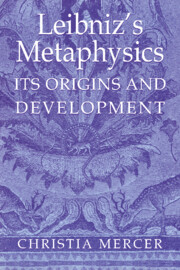Book contents
- Frontmatter
- Contents
- Acknowledgments
- References to Leibniz's works
- Introduction: first truths and half truths
- PART ONE METAPHYSICS OF METHOD
- PART TWO METAPHYSICS OF SUBSTANCE
- 2 Aristotelian assumptions, 1668–69
- 3 Original conception of substance, 1669
- 4 Second conception of substance, 1669–early 1671
- PART THREE METAPHYSICS OF DIVINITY
- PART FOUR METAPHYSICS
- Appendix I (Not exactly) First truths
- Appendix II Leibniz's original assumptions
- Bibliography
- Index Locorum
- Index
4 - Second conception of substance, 1669–early 1671
from PART TWO - METAPHYSICS OF SUBSTANCE
Published online by Cambridge University Press: 12 March 2010
- Frontmatter
- Contents
- Acknowledgments
- References to Leibniz's works
- Introduction: first truths and half truths
- PART ONE METAPHYSICS OF METHOD
- PART TWO METAPHYSICS OF SUBSTANCE
- 2 Aristotelian assumptions, 1668–69
- 3 Original conception of substance, 1669
- 4 Second conception of substance, 1669–early 1671
- PART THREE METAPHYSICS OF DIVINITY
- PART FOUR METAPHYSICS
- Appendix I (Not exactly) First truths
- Appendix II Leibniz's original assumptions
- Bibliography
- Index Locorum
- Index
Summary
In 1671, Leibniz published two related works which constitute his first extended account of the laws of motion and their metaphysical foundations and which he considered important (and good) enough to bring to the attention of some of the most powerful intellectuals in Europe. The first, the New Physical Hypothesis, subtitled Theory of Concrete Motion, he dedicated to the Royal Society of London; the second, the Theory of Abstract Motion, he dedicated to the French Academy of Sciences. Together, these works, which Leibniz often refers to as the Schediasma in his correspondence, propose a physical system replete with creation story and laws of collision. A year after the publication of the texts, Leibniz left for his four year stay in Paris, where he was to meet and converse with many of the leading philosophers, scientists, and mathematicians of his time. That the Schediasma is the culmination of Leibniz's early study in natural philosophy is clear. But it also seems obvious that its conception of substance represents a dramatic change from the position in the letter to Thomasius of April 1669. In the letter, body qua matter, which is a being in space, is activated by God and thereby becomes a corporeal substance whose nature is described as its substantial form. In the Theory of Abstract Motion, Leibniz maintains that bodies are momentary minds whose every action is a momentary endeavor or conatus.
- Type
- Chapter
- Information
- Leibniz's MetaphysicsIts Origins and Development, pp. 130 - 170Publisher: Cambridge University PressPrint publication year: 2001



